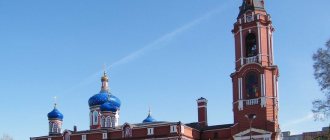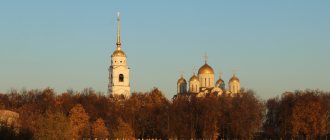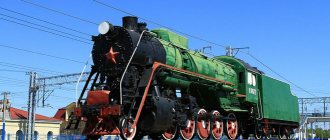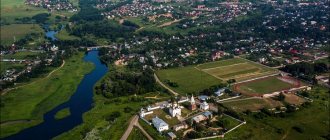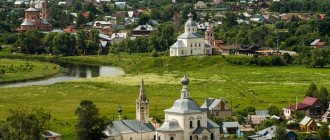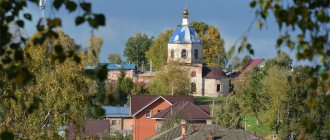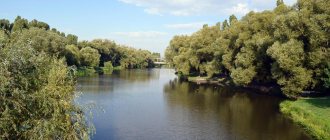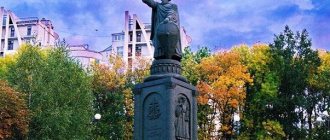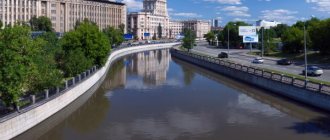If you are tired of the hustle and bustle of big cities, go to Orekhovo-Zuevo. Walking along the green streets and city parks, you can feel the atmosphere of a provincial town and explore architectural monuments. All the main attractions of Orekhovo-Zuevo can be seen in one day, as they are located in the central part of the city.
And would you like to know some interesting stories about this? For example, what does football have to do with Savva Morozov’s department store? Read on to find out more.
| Date of foundation of the city of Orekhovo-Zuevo: | 1209 |
| City population: | 118,822 people. (2018) |
| A district of the city: | 36.38 km² |
Historical facts about the city
The chronicles of the 13th century mention a battle between the Ryazan and Vladimir princes. This happened in these very places near the Drozdna River.
The chronicle of 1209 mentions the settlement of Volochok Zuev. This date is considered the founding day of Orekhovo-Zuevo. The city was officially founded in 1917 by merging the villages of Zuevo, Orekhovo, Dubrovka and Nikolskoye. The names of both settlements were used. The new formation was completely included in the Moscow province (previously, part of this territory belonged to the Vladimir province).
There are other theories about why the city was named so:
- Walnut groves grew on the banks of the Kluzhma River. They also became a habitat for wading birds and beetles.
- The idea for the name arose from the Old Russian names Oreh and Zuy.
Before the arrival of Soviet power, these settlements lived their own lives.
In Orekhov, the main occupation of the peasants was until 1771, when two of them began to weave silk products. After 26 years, there were already 9 such factories, employing 63 people. They were called silk weaving "factories". Every year their number grew. The village grew due to the people who came to it. In 1914, 2,297 people already lived here.
Nikolskoye is immediately associated with the name of Savva Morozov and his activities. The beginning of textile production dates back to 1797, when the peasant Savva Morozov founded his first enterprise. Work on it was done manually. The first product was silk, then wool.
It existed for 23 years. Savva was freed from serfdom and began purchasing land and building factories (spinning and paper weaving), and began finishing and dyeing production. His sons helped him in everything. 1847 marks the beginning of cotton production, which played an important role in the economy of the region.
Historical materials contain information about the existence of 17 factories at the end of the 19th century. More than 30 thousand people worked for them.
The creation of the Moscow-Nizhny Novgorod railway line, which passed through Orekhovo, also contributed to the economic development of the area.
A football team was born in this area.
The Morozov family purchased the latest equipment, machines and invited specialists to England. Interestingly, the advertisements stated that they were looking for mechanics and engineers who were well versed in football. Those who agreed to move were provided with housing. There was even a street of “English girls”. They attracted Russian workers to the game. This was the beginning of the development of football in Orekhovo-Zuevo.
Workers were forced to play football to avoid drinking alcohol. The date of the first match played is 1888. Morozov's team became the champion of Moscow four times and was considered one of the best in Russia. It exists to this day under the name “Banner of Labor”.
We should not forget about the famous Morozov strike of 1885, which took place at the Nikolsky plant. About 8 thousand people took part in it, dissatisfied with low wages and fines. This continued for 10 days. Despite the suppression of this action, the workers managed to achieve improved working conditions.
Weaving factory building
Today, some of the factory buildings have been sold for shops and offices, while others are simply abandoned. People who do not have a permanent place of residence live in them.
In 1886, Orekhovo, Zuevo and Nikolskoye no longer looked like ordinary villages. In fact, they merged into one whole, formed as a large industrial city with two-story stone houses, taverns, shops, churches and factory buildings. Lenin, who visited these places, noted their originality. He noted that practically the only authority there was the plant administration.
Orekhovo-Zuevo attractions
One of the villages was located in the Moscow province, the second belonged to the Vladimir province. The village on the Moscow side has become famous thanks to local textiles since the 18th century. Today's review is a story about the birthplace of Russian football, Orekhovo-Zuevo attractions.
Sights of Orekhovo-Zuevo and a little about the city
Before the revolution, Zuevo lived its own life, Orekhovo its own, Dubrovka and Nikolskoye, respectively, too; it was these four separate administrative-territorial units that were merged into one whole. In Nikolskoye there was a trading house of Savva Morozov, one of the largest enterprises in the country. To keep workers from drinking alcohol, they had to play football. The first match was played in 1888. in Russia before the 1917 revolution . The local population is 120 thousand people.
Orekhovo-Zuevo Moscow region on the map
Museum of History and Local Lore
History buffs will want to first explore this museum, which houses a huge collection of photographs, examples of commemorative porcelain and many other exhibits. It was founded in 1929 and was called "Weaving".
Although part of the museum's collection was destroyed during the war, and another part was lost when the roof collapsed, many interesting exhibits have been preserved. Its collection includes up to 40,000 exhibits. Among them:
- archaeological finds dating back to ancient times;
- collections of icons, coins, vessels, clothing;
- items telling about the history of football;
- rare vintage photographs of old streets and their modern appearance;
- postcards with views of Morozov's factories and samples of their products;
- paintings by local artists from the last 100 years.
The area of the museum is 325 m2.
Museum of History and Local Lore
His guide will introduce you to the history of the development of the textile industry and the collection of porcelain products from the Dulevo factory. The museum has an audio guide and a mobile guide.
Opening hours: daily, except Monday and Thursday, from 10.00 to 18.00, on Thursdays until 20.00. Monday is a public holiday.
More detailed information can be found on the official website of the museum. Address: Klyazminsky Avenue, 7.
Orekhovo-Zuevo attractions
Orekhovo-Zuevo Museum of Local Lore
This institution is also known under the simple name Exhibition Hall. Located on Klyazminsky Proezd. Its history dates back to 1929, when a museum called Tkach was created.
The exhibition often changed its location; during the war with the fascist invaders, many items from the museum’s collection were destroyed, but some still survived to this day. After the war, the establishment was again unlucky; in the building where it was located, the roof collapsed in 1966, and some of the exhibits were lost again. Then he changed his location, being in various buildings of the local businessman Morozov, until on the millennium he found his own building, built in 1937.
Now the fund includes 40 thousand items. Among the interesting exhibits are items related to the history of football. You can see some of the 800 paintings by local artists.
The first floor of the institution is accessible to visitors with disabilities.
The entrance fee is 55 rubles for an adult.
The institution is equipped with an audio guide and a MAUGRY mobile guide.
The establishment's opening hours are from Tuesday to Sunday from 10:00 to 18:00, on Thursday until 20:00.
Orekhovo-Zuevo Museum of Local Lore official website
https://ozmuseum.ru/about-museum/
Cathedral of the Nativity of the Virgin Mary
This iconic building is located on Volodarsky Street. The building was built in 1871 at the request of local residents. There was not enough money to complete the construction; the temple took 19 years to build.
The church has five domes, the design symbolizes a ship, made in red brick. Historians say that the interior painting was carried out by Vasnetsov.
Many icons that have historical value are kept here, for example, the icon of the Kazan Mother of God, the icon of Sarov, Radonezh and St. Nicholas the Wonderworker.
The temple celebrated its 120th anniversary, the gift of which was its large-scale restoration, the main goal of which was to preserve the historical appearance of the church as close as possible to the original.
Cathedral of the Nativity of the Virgin Mary official website
https://oz-blago.ru/khramy/item/44-bogoroditserozhdestvenskij-sobor-g-orekhovo-zuevo
Guslitsky Monastery Orekhovo-Zuevo
The men's monastery was founded in 1858. The main goal that was pursued when creating the monastery was teaching children and missionary work.
The first abbot was also a builder who was directly involved in the construction of this complex. For his labors, Father Parfeniy was awarded the highest award among the clergy - a golden pectoral cross; in addition to the Guslitsa monastery, he took part in the construction of many religious buildings in other cities and villages.
All this can be found on the official website of the monastery
Guslitsky Monastery Orekhovo-Zuevo official website
https://guslickiy.ru
There was a very rich collection of Russian icons, which numbered more than 500 faces. After the Bolsheviks seized power, the complex was used as a colony for juvenile delinquents. In the post-war period, people suffering from mental disorders were treated here.
At this time, the bell tower, erected in 1916, whose height reaches almost 60 meters, is in dire need of restoration. In one of its tiers there was a temple. During the Soviet years it was used as a water tower.
You can see the preserved Church of the Transfiguration of the Lord and the bell tower thirty kilometers from Orekhov-Zuev, in the village of Kurovskoye, along Lesnaya Street.
Orekhovo-Zuevo attractions
Monument to the Morozov strike Orekhovo-Zuevo
When talking about the sights of Orekhovo-Zuevo, it is necessary to talk about this monument.
There were large-scale celebrations in 1985, when almost all city residents celebrated the 100th anniversary of this event in January. In general, the town is considered one of the centers of the revolutionary movement. During the celebration of this round anniversary, a monument dedicated to the workers' strike was erected.
The supplier of the bronze composition is the Mytishchi Art Casting Plant, whose products are even in the Far East, for example in Komsomolsk-on-Amur. Bronze figures of weavers and spinners stand holding hands tightly, symbolizing their solidarity.
If you get on Stachki Street, you can plunge into the atmosphere of that time. The strike that happened here in 1885 was the largest in the Russian Empire. The fact is that many strike participants were acquitted in court, they achieved improved working conditions and increased pay.
For example, after this event, stone buildings began to be built for workers instead of wooden barracks, some of which still stand. The former buildings of the Morozov factory can be seen on Lenin Street, mostly built of red brick.
Reindeer Orekhovo-Zuevo
Yes, don’t be surprised, this is the name of the local deer farm, which has existed since 2003. On the official page of this establishment, it is stated that this is a real piece of the North.
Reindeer Orekhovo-Zuevo official website
https://www.severolen.ru/index.php/features
15 deer live on three hectares of land.
The history of the creation of the farm began in 2003, when two individuals that were supposed to be slaughtered in one of the Kola farms were saved from death. The deer got used to the new place, acclimatized and began to trust people. At that time, even in the Moscow Zoo there were no horned representatives, and the first excursions only confirmed the correct decision made to create a tourist attraction of this type.
What is offered here now... There are several programs, for example, the standard program, which on weekdays will cost 650 rubles per person, includes an excursion, the opportunity to communicate with animals, and in winter also ride in a reindeer sleigh in the snow. Be sure to pre-book the service.
In summer, the farm can be visited without prior reservation in zoo mode.
The entrance fee for one adult will be 200 rubles.
Also in the summer you can go fishing with your own fishing rods; you can take crucian carp home completely free of charge; for silver carp they will ask for 350 rubles per kilogram.
You can visit the farm from Friday to Sunday in zoo mode from 11:00 to 16:00.
You can find deer in the village of Antsiferovo on Zelenaya Street.
Orekhovo-Zuevo attractions
Banner of Labor Stadium Orekhovo-Zuevo
This is the name of the local stadium, one of the first in the country, built in 1914 with the help of the British.
For the first time, a drainage system was used here, which allowed water to drain from the field within an hour after rain.
The University of London team played at the opening of the sports facility.
The field at that time was the best and most progressive structure in the Russian Empire.
Now the stadium can accommodate 6 thousand spectators, is recognized as the oldest sports facility, and is the arena of the local football club.
Located on Torfontransportnaya street.
Near the stadium there is a monument to the fallen members of the team, whose members died in a car accident in 2006. There is a soccer ball on the pedestal as a memory of the athletes.
Bugrova Street Orekhovo-Zuevo
You should definitely walk along this street, which is literally filled with local landmarks.
The street received its name in honor of one of the active participants in the Morozov strike. What can you see here?
Bugrov lived in the second house, which was then the so-called workers’ barracks, part of the 1908 building; the house itself was built in the Art Nouveau style, like many other buildings in this quarter.
Next to one of the barracks, the remains of an old water tower, which was built in 1896, have been preserved; it is sometimes compared to the London Big Ben; there was also a huge clock that previously hung here, which showed the time on four dials in all directions.
The clock worked until 1977, now almost all architectural monuments are in a state of destruction, they are not protected by the state, you can get there without hindrance.
On the same street you can see the Winter Theater, the exterior of which has been preserved in good condition. The building is used for its intended purpose; here you can go to a performance or other cultural event.
In addition, here you can see the pre-revolutionary hospital building and the religious building, the Chapel of Xenia of St. Petersburg.
Dulevo Porcelain Museum Orekhovo-Zuevo
Orekhovo-Zuevo attractions, on a good summer day, if you really want, you can get around in one day; when traveling by car, the time spent will be even less, since all the interesting points are concentrated in the central part of the settlement. If you have plenty of free time, we recommend visiting another establishment, which is located just 14 kilometers from Orekhov-Zuev. This is a town called Likino-Dulino and its porcelain museum. They began making dishes here back in 1832. After a little time, this factory becomes the leading production in the country, and tableware receives recognition abroad. The museum is located on the fifth floor of the factory; tickets can be purchased at the box office of the company store; the entrance fee will cost 200 rubles. The Dulevo porcelain sign can serve as a reference point. The building where you can find the sign is located on Lenin Street. The museum is new and quite spacious; the exhibits on display here range from the so-called Kuznetsov era to the present. On the museum website, you can sign up for a tour in advance.
Dulevo Porcelain Museum Orekhovo-Zuevo official website
https://dfz.ru/muzei/
The institution is open from Tuesday to Friday from 9:00 to 16:45 with a lunch break that lasts 45 minutes, starting at 12:00. No lunch on Saturday, day off on Sunday.
Cathedral of the Nativity of the Virgin Mary
It was built at the end of the 19th century at the request of residents. Construction took 19 years due to lack of funds to complete it.
Tourists pay attention to 5 domes with octagonal crosses covered with gold. As they get closer, they see a red brick building with a cut stone plinth. Its peculiarity is that it is built like a ship. The surface area of the cathedral is 1240 m2.
Cathedral of the Nativity of the Virgin Mary
The interior paintings of the church were done by Vasnetsov. Historians talk about this.
On the territory of the cathedral there are:
The cathedral contains icons of Our Lady of Kazan, St. Nicholas the Wonderworker, Sergius of Sarov and Sergius of Radonezh, which are of historical value.
Not long ago the church was restored again. However, its historical appearance has been kept as close to the original as possible.
Location of the cathedral: Volodarsky street, 20/1.
1.5.1. St. Nicholas Church (right bank part, in the school building) (1908, rebuilt, house at the school).
1.6.1. Dmitrievskaya Chapel (on the territory of the military unit of the Ministry of Internal Affairs) (2003).
1.7.1. Nativity of the Mother of God Old Believers (formerly Pomortsev) church (left bank part, formerly the village of Zuevo; Sovkhoznaya str., 15) (1884).
1.8.1. St. Nicholas Old Believer Church (left bank) (late 19th century, heavily rebuilt).
1.9.1. Mosque (near the station) (2000).
1.10.1. Church of the New Martyrs of Orekhovo-Zuevsky (near the station) (under construction).
City of Drezna
2.1.1. Pyatnitskaya Church (1996).
Kurovskoye town
3.1.0. Guslitsky Transfiguration Monastery (northwestern outskirts of the city). Founded in 1381 Valid. Spassky Cathedral (1886); Church of the Resurrection (1860s); Church of the Sorrows (late 19th century, in a cell building); bell tower (1913); fence with towers (1878); cell buildings (late 19th century).
3.2.1. Church of St. John the Climacus of the Single Faith (in the city center) (1996).
City of Likino-Dulevo
4.1.1. St. John the Theologian Church (in the city center) (1901-1915).
4.2.1. All Saints Church (in the cemetery, northern outskirts) (2000-2001).
Villages, hamlets, tracts
5. Abramovka 5.1.1. St. Nicholas Old Believer Church (1908, rebuilt).
6. Avsyunino 6.1.1. Church-school of Peter the Metropolitan (1905, former Edinoverie).
7. Antsiferovo 7.1.1. Wooden Chapel of the Royal Passion-Bearers (2003).
7.2.1. Intercession Old Believer wooden church (1910s, completely rebuilt).
8. Beliveau 8.1.1. Old Believer wooden prayer house (XIX-XX centuries).
9. Voinova Gora 9.1.1. Assumption Church (1830s, 1855).
10. Mountain 10.1.1. Nativity of the Virgin Mary Church (1877).
10.2.1. Nadkladeznaya chapel (near the village) (late 19th century).
11. Humpback whale 11.1.1. Trinity Church (1849, bell tower 1862, in serious condition).
12. Gridino 12.1.1. Elias Chapel (2005).
13. Gubino 13.1.1. Kazan Old Believer Church (1889, intact interior decoration from the 19th century).
14. Davydovo 14.1.1. Exaltation of the Cross Old Believer wooden church (early 2000s).
15. Dorofeevo 15.1.1. Chapel (late 19th century).
16. Woodcutters 16.1.1. Nikitskaya Church (1897, rebuilt).
17. Dubna Bolshaya 17.1.1. St. Nicholas Church (1839, in serious condition).
18. Dubna Malaya 18.1.1. Transfiguration wooden church (under construction).
19. Confusing 19.1.1. Kazan Church (1904, in serious condition).
20. Ilyinsky Pogost 20.1.1. Church of the Resurrection (1840).
21. Kabanovo 21.1.1. Nikitskaya wooden church (1891, wedding 1957, covered with brick in 1996; interior decoration of the mid-20th century is intact).
22. Red 22.1.1. Assumption Church (1836).
22.2.1. Chapel (early 1880s).
22.3.1. Peter and Paul Overlay Chapel (near the village).
23. Malkovo 23.1.1. Church of the Nativity of Christ (1893, former Edinoverie).
24. Milk 24.1.1. Intercession Old Believer wooden church (2003).
25. Nesterovo 25.1.1. Nativity of the Virgin Mary Church (1849, interior decoration of the late 19th century is intact).
26. Nikulino 26.1.1. Intercession Old Believer wooden church (1915, rebuilt).
27. Island 27.1.1. Trinity community with a church (1990s, “Valentinovites”).
28. Pashnevo 28.1.1. Church of the Intercession (1849).
29. Rudnya-Nikitskoye 29.1.1. Nativity of the Virgin Mary wooden church (1782, intact interior decoration from the 19th century).
29.1.2. Nativity of Christ wooden church (1st half of the 18th century, 19th century, interior decoration of the 19th century intact).
30. Savinskoe 30.1.1. Church of Our Lady “Seeking the Lost” (1890s, rebuilt).
31. Slobodischi 31.1.1. Kazan Old Believer Church (late 19th century, interior decoration of the 19th century intact).
32. Old Pokrov 32.1.1. Church of the Intercession (1845, the interior decoration of the 19th century is intact).
33. Ustyanovo 33.1.1. St. Nicholas Old Believer Church (1914, intact interior decoration from the early 20th century).
34. Hoteichi 34.1.1. Trinity Church (1823, bell tower 1851).
35. Yurkino 35.1.1. Seraphim Church (under construction).
36. Yakovlevo 36.1.1. Church of the Intercession (1909).
Compiled by: Alexander Bokarev, 2002-2007
Cathedral Mosque
This stone building appeared in the city in 2001. A crescent moon is visible on its minaret. The mosque was founded by Tatars from Orekhovo, who previously formed a Muslim religious community.
Cathedral Mosque
The mosque hosts Sunday school classes, where the basics of Islam and the Holy Quran, Arabic, the history and culture of the Tatars, and the rules of Muslim etiquette are taught.
As part of summer activities, excursions to other mosques are organized for children. There is a Tatar youth club here.
Address: Lapina Street, 28.
Sculptural landmarks
Orekhovo-Zuevo is famous for its large number of monuments. Although the city is considered still young, there is a lot to see in it. The sculptural sights of Orekhovo-Zuevo always attract tourists:
- Monument to A.S. Pushkin. This attraction appeared in the city in 1957 on the square named after the great Russian poet. The sculpture was erected in honor of the 120th anniversary of the memory of Alexander Sergeevich. The poet has very warm memories associated with Orekhovo-Zuevo. It was here that the work “My Genealogy” was born.
- Monument to the fighters of the revolution. In 1923, this landmark was erected in the courtyard of the Strike. Throughout its history, the monument has been “changed” into a new look three times.
- In the 80s, a monument was erected on Oktyabrskaya Square in the city in honor of the Morozov strike of 1885. This interesting monument is an interesting bronze composition of several figures.
Guslitsky Monastery
The monastery was founded in 1858 under the name Spaso-Preobrazhensky Monastery. This was the wish of Emperor Alexander II. The purpose of its creation was to educate children and missionary activities.
The construction work was supervised by the first rector, Father Parfeniy. For this he received the highest church award - a golden pectoral cross.
The monastery housed a rich collection of Russian icons - up to 500 icons.
The monastery ceased to exist in 1920. It housed a colony for juvenile delinquents and, after the war, a hospital for the mentally ill. The bell tower, erected in 1916, served as a water tower. Its height is close to 60 meters.
The monks settled in the monastery again only after 78 years. Since then, restoration work has been carried out here.
Guslitsa Monastery
The monastery has two Sunday schools where children and adults study Orthodoxy, a family club, a carpentry workshop and an icon painting workshop. And in the summer there is a family camp near Lake Seliger.
The monastery is located 30 km from Orekhovo-Zuevo, in the village of Kurovskoye, on Lesnaya Street.
How to get there?
You can get from Moscow to Orekhovo-Zuevo by car, train, shuttle bus, or train. The city is located 90 km from the capital, and transport links are well established.
- A train ticket costs 220 rubles; if you buy a monthly pass, the journey will cost much less. Electric trains from Moscow travel in the desired direction every 10–30 minutes, the journey time is about one and a half hours.
- You can get to Orekhovo-Zuev from the capital by shuttle bus from the bus station near the Partizanskaya metro station. Travel time is about 2 hours, 4 flights depart on weekdays.
- If you have your own car, you can get from Moscow to Orekhovo-Zuevo along the M7 Volga highway. In the village of Malaya Dubna, turn onto the A108 highway.
In Orekhovo-Zuevo you can take a break from the bustle of big cities. Green, cozy streets and city parks allow you to plunge into the atmosphere of a provincial Russian city and remember the history of Russia.
Architectural monuments
One of the oldest surviving buildings from the late 19th century is the Ogloblin House. Until 1905, the director of the factory, Morozov, lived here. After the arrival of Soviet power, the following were located:
Today it is a department of the regional psychiatric hospital.
House in Ogloblin
There is a memorial plaque dedicated to Ogloblin on the house.
Address: Lenin street, 48.
On the same street is the Old Soviet House, a 3-story building built in 1912. The author of the project is the architect Bugrov.
Workers, engineers and medical workers from the Nikolskaya Manufactory factories lived in the house. The unusualness of its layout lies in the abundance of small rooms and long corridors.
City parks
If you are tired of wandering around the city, you can relax in one of the parks and enjoy the thrills, concerts and shows. Both tourists and locals enjoy the Mill Forest, known as the Park Forest.
The place where Morozova stood was chosen as the site for the City Park of Culture and Recreation. Members of the Morozov family, management and other workers of the Morozov factory lived in it. There was a fence around it. The entrance was guarded.
In 1918, a children's park with functioning carousels, a shooting gallery, a library, and a checkers and chess corner appeared here. Later a theater and restaurant were opened here.
They have been neglected for a long time. In 2011, work began to improve it. It was decorated with fountains, flower beds and tree plantings. New attractions have been added.
Now the city park has many exciting attractions:
How much fun it is for children to visit a petting mini-zoo, ride electric cars, ride a mini-train, or go through a laser maze.
City Park
There is a pond in the park. Water lovers can go sailing, ride a catamaran, and fishermen can go fishing.
The park also has a restaurant serving Japanese rolls, juicy pizza, hot dishes and delicious desserts.
Sit under the shade of the trees and use the wireless internet access.
The city park is located at Komissariatsky deadlock, 7.
30th anniversary of the opening of Victory Park in 1975.
30th anniversary of Victory Park
It was abandoned for some time and gradually fell into disrepair. In 2011, the city park changed from day to day. A fountain was installed and the area was landscaped. Its former popularity is returning.
The 1st May Park was formerly called the Morozov Park of People's Pleasure. It was a favorite vacation spot for workers at the Nikolsky plant.
1896 is the date of construction of the area for the summer theater. The first performances took place on an open stage. A few years later, a theater with an auditorium for 750 seats was built on this site. In buffets and on benches, workers were offered fruit and sour cream.
Reindeer Farm
The farm was created in 2003 on an area of 3 hectares. It all started with the settlement of a pair of reindeer, which soon gave birth to offspring.
At the farm, guides talk about the traditions and customs of the peoples of the North. Workers wear national costumes of the northern peoples.
Deer farm
Visitors are offered a master class on the principles of reindeer husbandry and reindeer riding. You can even feed the animals by hand, which is especially popular with children.
Farm location: Antsiferovo village, Zelenaya street. In summer (June-August) it operates like a zoo. Opening hours: Friday, Saturday, Sunday 10.00 - 16.00. Tours are available throughout the year but must be booked in advance.
Additional information on the website.
Dulevo Porcelain Museum
The Dulevo porcelain factory has existed since 1832. Soon her dishes gained recognition not only in Russia. It is popular all over the world even now. The originality of the Dulevo “agashka” style is in simplicity, originality, preservation of national characteristics and traditions. “Agashka” is a light purple flower painted on the dishes.
On the territory of the factory there is a museum with unique antique examples of services and various porcelain exhibits. Museum staff conduct excursions, introducing visitors to the production, and give master classes on painting boards.
Porcelain Museum Dulevo
Address: Likino-Dulevo village, Lenina street, 12. Schedule: Tuesday to Saturday - from 9.00 to 17.00, break from 12.00 to 12.45. There is no break on Saturday. Days off are Sunday and Monday. The excursion must be booked in advance.
